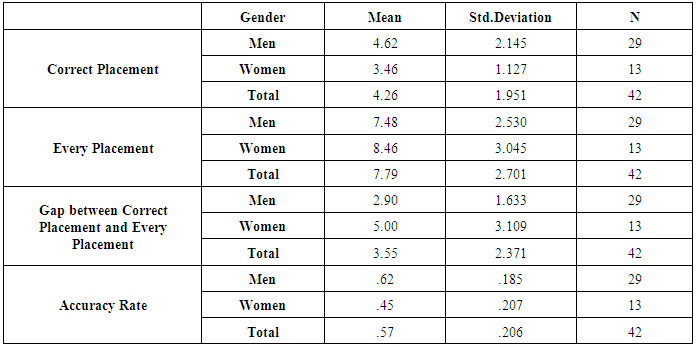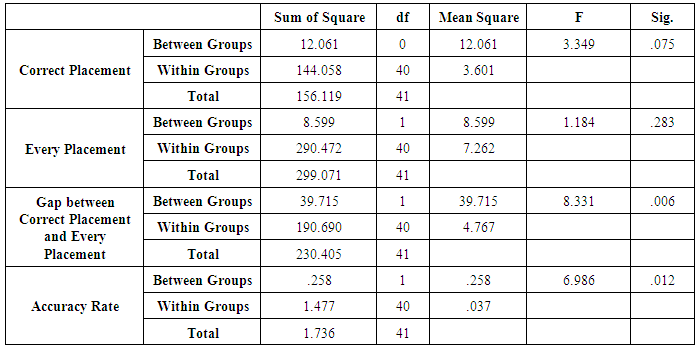-
Paper Information
- Previous Paper
- Paper Submission
-
Journal Information
- About This Journal
- Editorial Board
- Current Issue
- Archive
- Author Guidelines
- Contact Us
International Journal of Psychology and Behavioral Sciences
p-ISSN: 2163-1948 e-ISSN: 2163-1956
2016; 6(2): 91-98
doi:10.5923/j.ijpbs.20160602.09

Exploring Gender Differences in Spatial Orientation Ability on Representing Cognitive Map
Yohan Moon 1, Hwiyeol Jo 2, Jongin Kim 3, Jeong Ryu 4
1Department of Interactional Science, Sungkyunkwan University, South Korea
2Department of Computer Science & Engineering, Seoul National University, South Korea
3Interdisciplinary Program in Cognitive Science, Seoul National University, South Korea
4Department of Psychology, Yonsei University, South Korea
Correspondence to: Jeong Ryu , Department of Psychology, Yonsei University, South Korea.
| Email: |  |
Copyright © 2016 Scientific & Academic Publishing. All Rights Reserved.
This work is licensed under the Creative Commons Attribution International License (CC BY).
http://creativecommons.org/licenses/by/4.0/

This study examines that there are gender differences of spatial orientation skills in drawing cognitive maps which represent narrative space after reading a book. Because there was no previous research proposing specific way of measuring accuracy of spatial orientation skill in cognitive map, we propose a new experimental tool which helps interpret cognitive maps quantitatively in the aspect of spatial orientation ability. Result from this experiment shows there is no significant gender difference in recalling the number of places of narrative spaces. However, we found that men perform better than women in locating places accurately in cognitive map. This result provides evidence that men have better spatial orientation ability in representing cognitive map of narrative space. Finally, we discuss various possibilities of interpretation, the visuo-spatial working memory (VSWM) span and systemizing information. The limitation will be discussed.
Keywords: Cognitive Map, Gender Differences, Spatial Orientation ability, Visuo-Spatial Working Memory (VSWM), Systemizing
Cite this paper: Yohan Moon , Hwiyeol Jo , Jongin Kim , Jeong Ryu , Exploring Gender Differences in Spatial Orientation Ability on Representing Cognitive Map, International Journal of Psychology and Behavioral Sciences, Vol. 6 No. 2, 2016, pp. 91-98. doi: 10.5923/j.ijpbs.20160602.09.
Article Outline
1. Background / Objectives and Goals
- There has been a plethora of researches on spatial orientation skills, which is the complex of abilities used for locating themselves with respect to a point of reference or an absolute system of coordinates, in the aspect of gender differences. Those researches has investigated spatial orientation skills in various environments including real environments (Malinowski & Gillespie, 2001) (Sadalla & Montello, 1989; Lawton, 1996; Lawton, Charleston, & Zieles, 1996) (Schmitz, 1997) (Kirasic, Allen, & Siegel, 1984; Montello & Pick, 1993; Saucier et al., 2002), simulated environment like 3-D computer simulations (Moffat, Hampson, & Hatzipantelis, 1998; Lawton & Morrin, 1999; Sandstrom, Kaufman, & Huettel, 1998; Waller et al., 2001), (O’Laughlin & Brubaker, 1998), and map (McGuinness & Sparks, 1983; Miller & Santoni, 1986). With an intensive research of previous studies, Coluccia and his colleague assumed the gender difference emerges only when the task requires high workload and Visuo-Spatial Working Memory (VSWM). They pointed out that VSWM is determinant factor in gender difference of spatial orientation ability, indicating that men would show better performance than women, because of their large VSWM span. In this study, we examine a bunch of cognitive maps of narrative space which is closely related to VSWM. because research on gender difference in cognitive map is almost uncharted territory. Though there have been already such a number of researches on spatial orientation ability on gender difference in various environment, a study on cognitive map of narrative space which is closely related to VSWM is almost uncharted territory. Therefore, in this study, we investigate the gender difference in spatial orientation ability with cognitive maps of narrative space quantitatively and qualitatively.The concept of cognitive map was first introduced by Tolman (1948) to account the navigational ability that helps rats reach to food box in a maze, when familiar way has been blocked. The term, cognitive map, has been used for various purpose of people’s concept of geographic maps such as road maps. Based on Lynch’s idea that ‘the observer of an environment selects, organizes, and endows with meaning what he see’ (1960), Bjornson extended the concept of cognitive map to literature. He suggested the extended concept of cognitive map to refer a global mental representation of the literary text that includes both spatial information and meanings the reader endows. Furthermore, Jameson suggested the concept of cognitive map should be extended from purely spatial to social domain (1988). However, in this study, we focus on narrow concept of cognitive map that is mental model of spatial relation, through representing narratives space. More specifically, this study aims to reveal gender difference of spatial orientation ability which is reflected in cognitive maps. It seems that there are mainly two difficulties in drawing cognitive map of narrative space. The first, to transform temporal dimension of languages into the spatial nature of maps, remembering spatial information which is partially distributed over all the text is required. The more the number of interacting element to be maintained simultaneously, the more cognitive load is required in working memory (Marcus, Cooper & Sweller, 1996). In other words, because the task, drawing cognitive map of narrative space, requires a high load of VSWM, it is difficult task. The second is that there are two steps which is ambiguous in the middle of transforming textual information into visual representation (Marie, 2003). According to Marie, there are three stage, textual information, mental models of space, and visual representation. Both between textual information and mental models of space, and between mental models of space and visual representation, there are incompleteness of texts and informational gap because visual representation is very explicit compared to textual information or mental models of space.Just reading also needs long term memory to remember a global representation, and sketch-pad of short term memory or episodic memory to remember smaller textual units. To represent the memory more explicitly, it is expected that high cognitive load would be needed.Research Question: Would the gender difference of spatial orientation ability emerge in drawing cognitive map of narrative space?
2. Methods
- This was exploratory study carried out in one of university in Seoul, Korea. 57 undergraduate students who registered for introductory cognitive science course participated in this experiment. Majors of students were various. The experiment was conducted during a spring semester. Participants were instructed to read the story of the novel, ‘Chronicle of a Death Foretold’ for two weeks. In class, they are required to draw a fictional town map individually in A4-size paper. Participants were debriefed at the end of the semester and awarded class credit for their participation.To measure spatial orientation ability quantitatively, we made new frame named Frame of spatial orientation ability measurement (FOM), which means a frame for spatial orientation ability measures. At first, we made a standard frame which exactly reflects master map drawn in previous research conducted with same fiction (Marie, 2003). We referred all items marked on the master map. And, we divided the map to 8 section equally based on cardinal points.Each of cognitive maps submitted had their separate cardinal points. To compare and assess accuracy of location of all those maps submitted fairly, certain criterion was needed. We selected two items which were the most often mentioned among those cognitive maps. The two most often referred items were House of Nassar and Square (see Figure 2). Based on those two items, we built an axis as criteria to help arrange and compare a number of cognitive maps. Number 23 and 7 on the left picture of Figure 1 is House of Nassar and Square, respectively. The reason why we selected the most often mentioned items was to make an axis that can include as many cognitive maps as possible in our research.
 | Figure 1. A master map by Marie and FOM overlaid on master map |
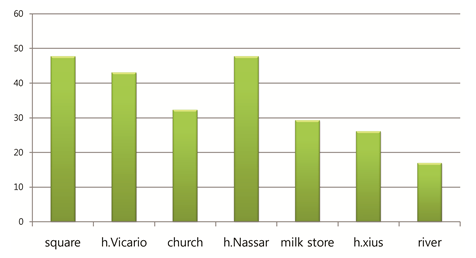 | Figure 2. Frequency of Items referred in cognitive maps |
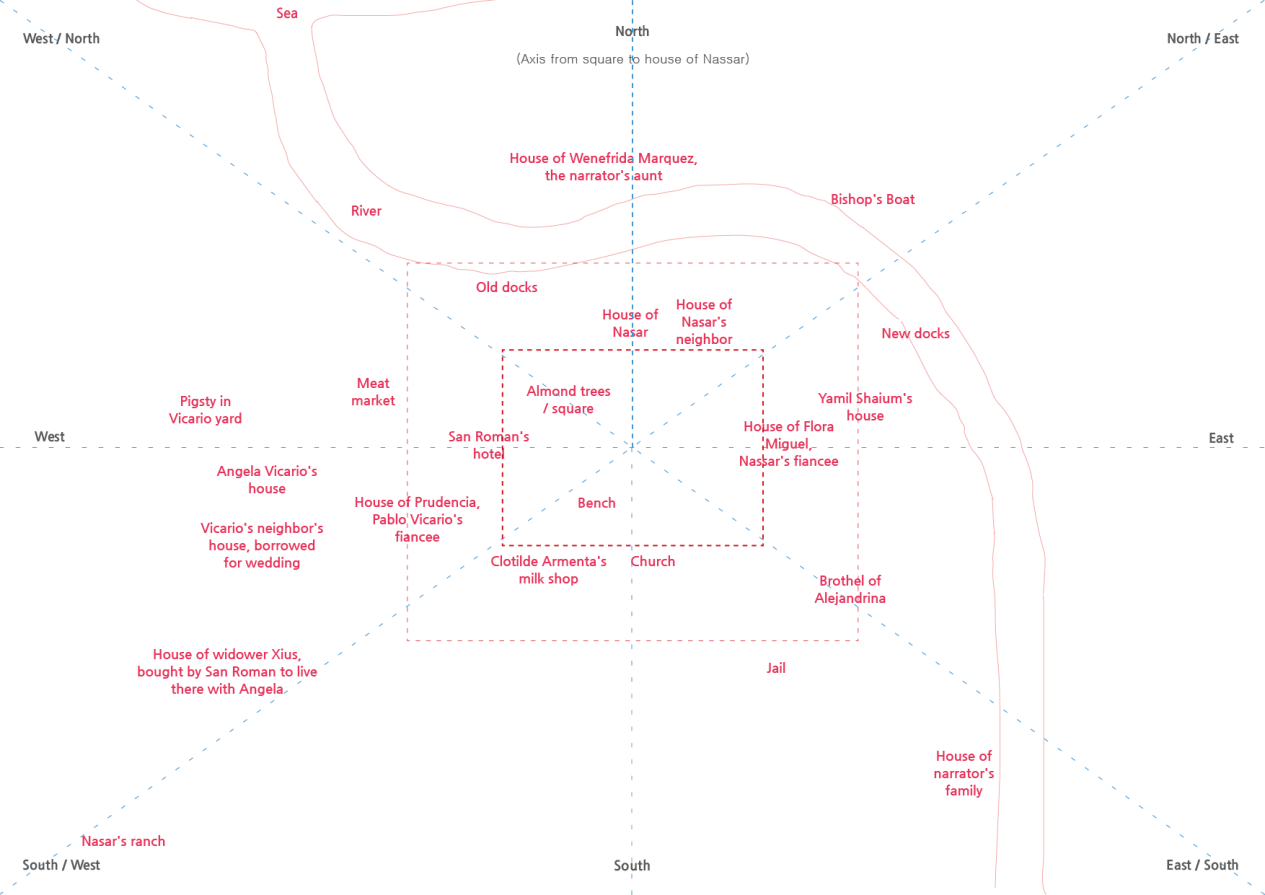 | Figure 3. FOM, a newly developed frame for analyzing cognitive maps in the aspect of spatial orientation ability |
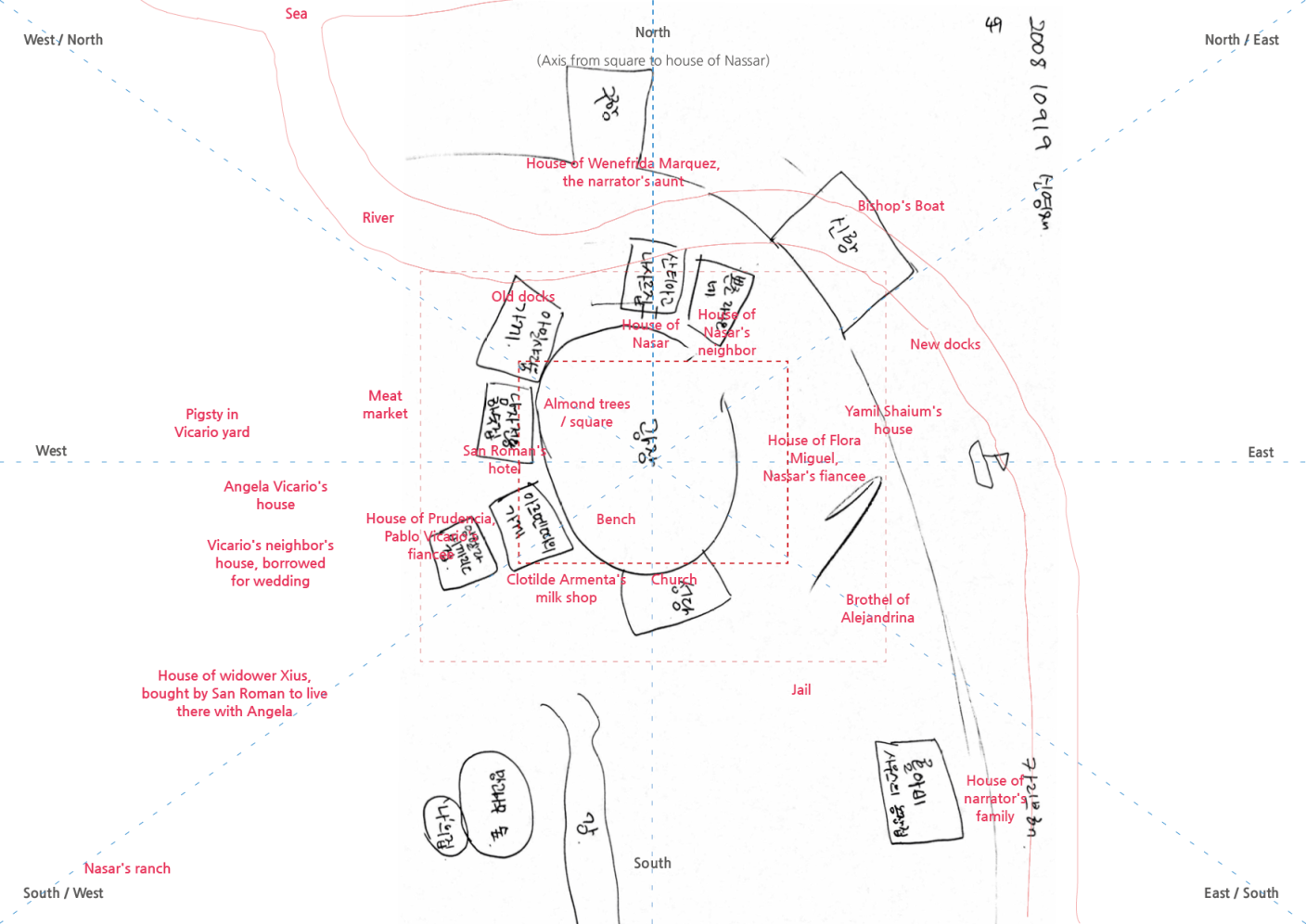 | Figure 4. One of the sample cognitive maps rotated 90 degree clockwise to get same direction with FOM |
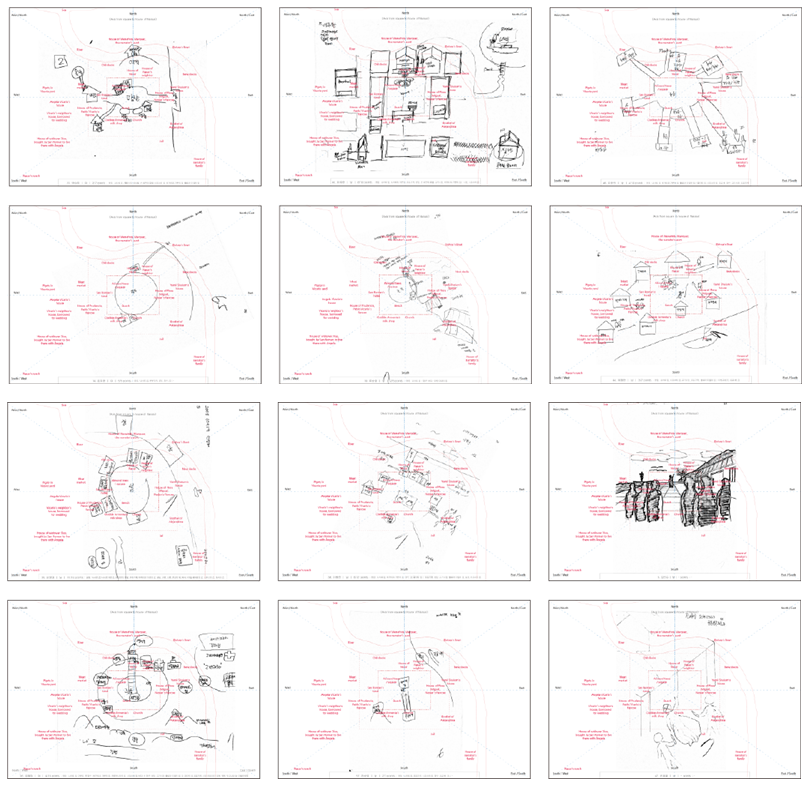 | Figure 5. Sample of cognitive maps overlaid on the FOM |
3. Results
3.1. General Information
- The items marked in correct place, every items marked, gap between items that match and every item marked, and accuracy rate are presented in table 1. All number of participant were 57, however, the maps we could use for this study were only 42. The average number of places marked in correct place, all items marked, gap between items marked in correct place and every items marked, and accuracy rate is 4.26, 7.79, 3.55, and 0.57, respectively.
|
3.2. Benefit Findings
- One-way analyses of variance (ANOVA) were conducted to analyze the gender difference in spatial orientation ability. The ANOVA indicated that men have a tendency to perform better than women in locating items in correct place, F(1, 40) = 3.346, p < .1, while there are no significant gender difference in recalling every items (see Fig.6).
 | Figure 6. Gender Difference in Number of Items Marked in Correct Place and All Items Marked |
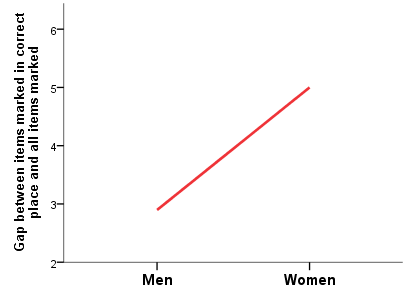 | Figure 7. Gap between items marked in correct place and all items marked |
 | Figure 8. Accuracy rate between men and women |
3.3. Discussions and Implications
- There are three interpretations of this gender difference in spatial orientation ability according to Coluccia and his colleague (Coluccia and Louse, 2004). First, there are evolutionistic theories hypothesizing that memory system women have has been specialized for object location since prehistoric age (Silverman and Eals, 1992). Women had to care of their family and daily supplies while men hunted developing their memory system in the aspect of Euclidean and configuration property. In other words, the gender difference in spatial orientation ability is attributed from traditional sex role. The second reason is assumed that men and women have different strategies in orientation task (Lawton, 1994). Men seem to employ a survey strategy, which utilize a global reference point and Euclidean information. The strategy is more useful in navigating than route strategy, which utilize landmarks and instructions on how to get to destination. Women usually have the route strategy. The third is personality. ‘Spatial anxiety’ or ‘fear to get lost’ reduces ability to catch cues for navigation. Because women have spatial anxiety while men shows confidence in finding way, it is hypothesized that men tend to have better spatial orientation ability (Lawton, 1996; Kozloswki and Bryant, 1977). Lastly, VSWM span is pointed as key determinant of gender difference in spatial orientation ability (Coluccia and Louse, 2004). Because our task had several difficult steps which require high level of VSWM, and it seems that there are significant gender difference in VSWM, it seems that the gender difference appears more distinctively in the result. With these factors previously referred about gender difference in spatial orientation ability, we suggest that gender difference in systemizing ability may have affected to our result. Systemizing, as one of two key mode of thought (Baron-Cohen, 2002), help to comprehend the rules controlling the behavior of a system and to construct lawful systems. Furthermore, with systemizing, we may predict and control these system (Goldenfeld, Baron-Cohen & Wheelwright, 2005). In our task, information on space should be scattered partially over the whole story. Considering characteristics of our task that include compiling partial information systematically, it is hypothesized that the ability of systemizing would affect to our task that reconstructing narrative space given partially to a piece of drawing.
|
 Abstract
Abstract Reference
Reference Full-Text PDF
Full-Text PDF Full-text HTML
Full-text HTML